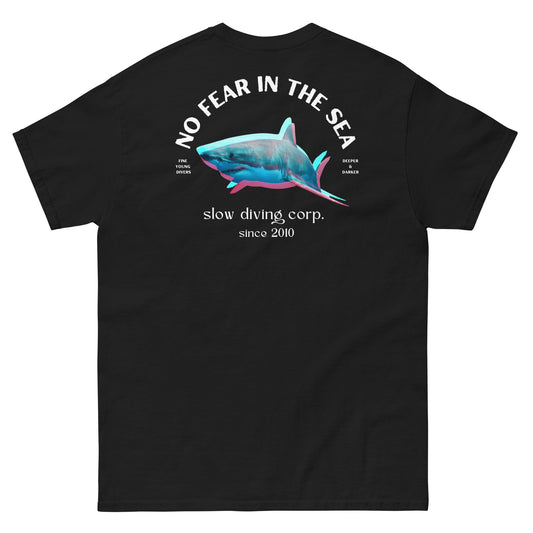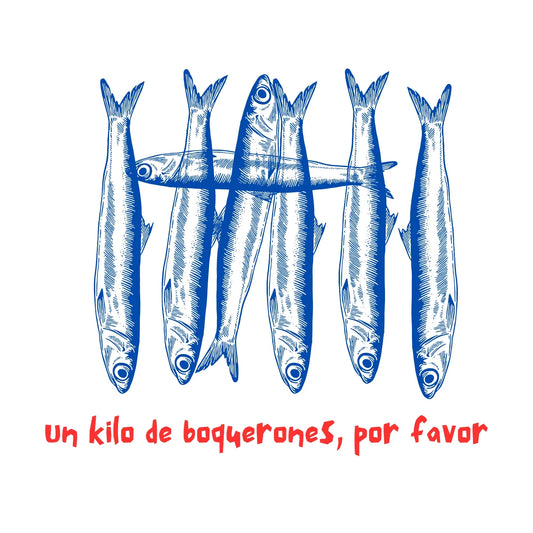Only few people associate the Mediterranean Sea with the presence of sharks... even though there are 90 species of sharks that live or pass through the Mediterranean Sea at any time of the year. Is important to note the huge damage that the Spanish fishing industry is doing to the conservation of sharks as it captures half of the specimens killed in the EU, being the third country in the world in number of shark catches.
By the way, did you know that we have a collection of shark T-shirts and sweatshirts? Top-quality and worldwide shipping.
In this series of three articles you'll learn more about 13 shark species that inhabit Mediterranean waters and their conservation status. But do not panic, if you usually swim or dive in the Mediterranean Sea you should know there have been only two shark attacks recorded in the past 400 years and none of them were fatal.
1. White shark (Carcharodon carcharias)

Yes, believe it or not, you can find white sharks in Mediterranean waters... although it is very unlikely as there have only been 23 documented great white sharks in the last 50 years. The great white, which became world famous and world feared because of Steven Spielberg's movie "Jaws", is almost impossible to be seen from the beaches of any Mediterranean country because they go straight to the Strait of Messina, where their presence is much more common and come together to mate.
The white shark, that flees from cold waters, can be found in all oceans of the world except in the Arctic and Antarctic. Although is capable of living up to 900 meters deep, it usually hunts between 3 and 25 meters, where it finds its food.
Due to its size, weight and power, it feeds on small whales, dolphins, sea lions and seals, and is also feeds on whale carcasses.
2. Porbeagle shark (Lamna nasus)

The Porbeagle shark is a shark species in a delicate situation, as it appears in the red list of the IUCN (International Union for Conservation of Nature, the oldest and largest environmental organization in the world) in vulnerable situation. The dramatic decline of its population due to the action of the man, capturing it for its flesh (this shark is known as "the calf of the ocean") and also for sportfishing. In the North Atlantic Ocean the population has fallen by 90% in less than 40 years.
These sharks can be found all throughout the Mediterranean Sea, the Azores and the Canary Islands. While rare, they are able to venture into beaches and ports during the summer months to find their food (cephalopods, sardines, mackerel and crustaceans). With a strong and robust body (can grow up to 3.5 meters and 225 kilograms) the porbeagle shark has no problem to include dolphins in its diet as it is a very fast and aggressive shark.
3. Blue shark (Prionace glauca)

The blue shark is one of the most widely fished shark in the European Union, exceeding 4,000 tons collected every year. Although it is impossible to make estimates of its population due to their migratory nature, IUCN has placed on its Red List as threatened.
Blue sharks inhabit all oceans and seas of the world, being able to migrate more than 5,000 kilometers. This is a large species of shark with an average length of 2.5 meters and weigh of 80 kilos. Their diet is similar to other sharks of its size: groupers, squids, mackerel, tuna...
4. Hammerhead shark (Sphyrna zygaena & Sphyrna lewini species)

Hammerhead shark specimens inhabiting the Mediterranean Sea are of course not very common, but they show up from time to time. This shark is also listed in the IUCN red list as in some areas of the Atlantic Ocean its population has declined by 95% in the last 30 years. Their fins are among the most coveted for cooking the infamous shark fin soup.
These sharks are mostly found in warm and tropical coastal areas between latitudes 46 ° N and 36 ° S. In Spain it was seen in the Balearic Islands quite commonly 20 years ago, and also in the Canary Islands, in the Atlantic Ocean. Although they can get to inhabit deep waters up to 500 meters, they usually spend most of their time around 25 meters deep. These species rarely exceed 4 meters in length and 150 kg in weight and their main food are cephalopods, rays, sardines and mackerel. They are not considered aggressive or dangerous to humans. Hammerhead sharks usually spend much time in large schools, a truly unique show.
5. Spiny dogfish (Squalus acanthias)

The spiny dogfish is a small shark just over a meter in length which has several characteristics that make it unique. On one side it is “equipped” with very sharp spines laden with poison and second, their way of expelling the embryos is very unusual as it does it... from the head!
Another notable feature of this elasmobranch is that it is in critical situation, according to data from the IUCN, in serious danger of extinction in North Atlantic coasts. The spiny dogfish is captured to prepare fish and chips, to cook shark fin soup or for its liver oil.
The spiny dogfish shark is a migratory animal looking for the deep waters of the coast able to reach up to 900 meters deep. This voracious and aggressive animal feeds mainly on herring and mackerel.
6. Basking shark (Cetorhinus maximus)

The basking shark is the second largest shark after the whale shark. It is a pelagic shark but can also be spotted near the coast, in shallow waters, almost always with his big mouth opened trying to filter plankton, small fish and crustaceans. Adult specimens weighing up to four tons and measuring 10 meters long are capable of filtering 2,000 tons of water every hour.
Its slow movements and human tolerance have facilitated indiscriminate hunting for their meat and to make oil from its huge liver, which represents the 20% of its weight and performs a key role in its buoyancy. Today the basking shark is listed as threatened species by the IUCN (International Union for Conservation of Nature).
Although they prefer cold waters, basking sharks can be found in all oceans.
7. Spinner shark (Carcharhinus brevipinna)

The spinner shark is a coastal shark that inhabits depths up to 100 meters but prefers to feed in shallow water, around 30 meters. The color of their fins makes it easy to mistake it for blacktip sharks, but these are smaller than the blackfin shark, which can reach 3 meters in length.
They feed on large schools of herring, sardines or anchovies, attacking the big schools with fast movements. They also hunt cephalopods, mollusks and even rays. Although it is not dangerous to humans because it does not have large teeth and its mouth is small, it is dangerous to approach them when they are feeding because of their swift and aggressive hunting technique. This shark uses a common hunting strategy shared with other sharks: attacking at high speed from the bottom being able of jump out of the water due to the fast and power of the attacks… this is the reason why it is called the spinner shark, because when it jumps out of the water they spin several times on the air.
In the Mediterranean Sea they can only be found in the North African coast. Although commercial fishing has been intense, the greatest danger for this shark lies is the degradation and pollution of their coastal habitats, but is not in serious danger of extinction.
8. Silky shark (Carcharhinus falciformis)

This shark is named after the texture of its very smooth and soft skin. Of all the species of this series of Mediterranean sharks, this one is possibly the most difficult to see in as it only penetrates very slightly in the Strait of Gibraltar and also because it is a species that spends most of his time around 50 meters of depth.
It is a migratory shark measuring up to 2.5 meters long which feeds mainly on schools of tuna and sardines but that it does not reject the opportunity to hunt some octopus or squids. There have been cases of attacks on divers and it is quite aggressive to humans, so it's best not to get too close to these animals if an accidental encounter happens, which, on the other hand, is not very likely because they spend most of their life at open sea.
9. School shark (Galeorhinus galeus)

If you've ever been to Andalusia it's possible you've eaten marinated school shark (called "cazón en adobo" in Spanish), and you did not know you were eating a shark. The school shark lives at depths of between 40 and 400 meters. Their fins are also highly prized for making shark fin soup. The shark inhabits the Mediterranean Sea and continuity in our seas is not in danger. It is a shark that lives near the bottom of the sea and reaches 2 meters long when adult. It feeds on cephalopods, crustaceans, and other demersal areas fish (which live attached to the bottom) like echinoderms and sea worms.
10. Shortfin mako shark (Isurus oxyrinchus)

The shortfin mako shark lives in almost every ocean of the world. Belonging to the same family as the white shark, the lamnidae family, is not hard to realize that we are talking about a large, aggressive shark that can grow to 4.5 meters in length and can weigh up to 750 kilograms, making it a powerful and fast fish. In fact it is one of the fastest ocean predators, capable of reaching speeds of up to 75 km/h.
With this size, strength and speed is not surprising that it can feed on small whales, dolphins, sea turtles, large tuna or swordfish, for which it is their main predator.
Being a pelagic shark is not common to see it near the coast although it is certainly possible when searching for food. In case it is not clear yet, it is a dangerous shark, and you must be very careful if you find it while diving. There have even been cases of attacks on boats. It is a species that is not in danger of extinction although it is vulnerable.
11. Thresher shark (Alopias superciliosus)
 Thresher shark (Alopias superciliosus). Pic by Rafn Ingi Finnsson
Thresher shark (Alopias superciliosus). Pic by Rafn Ingi Finnsson
The thresher shark is a curious shark with a tail fin of the same length as the rest of its body that unfortunately is currently among the most vulnerable shark species. The thresher shark is a pelagic shark that can be found in depths of up to 500 meters in waters between the tropics. It is also possible to see this beautiful shark in coastal waters and can be found in the Mediterranean Sea. Another notable physical characteristic of the thresher shark are its big eyes that help them find prey in low light conditions.
This shark has a curious way to get its food: when it detects a school of fish it approaches them very fast and hits the small fish with its tail fin to stun them and thus be able to capture them more easily. No wonder that in some areas of Latin America it is known as the "whipping shark".
The thresher shark is on the red list of threatened species by the IUCN (International Union for Conservation of Nature). It is a shark that poses no danger to man, both because its size (around 3-4 meters including the long tail fin) and by the shape of its mouth, but also because it is a shy and elusive fish.
12. Sand tiger shark (Carcharias taurus)
 Sand tiger shark (Carcharias taurus). Pic by Alex Mustard
Sand tiger shark (Carcharias taurus). Pic by Alex Mustard
The sand tiger shark inhabits coastal sandy bottoms up to 20 meters deep and in the Mediterranean Sea we can find it (if you are very very lucky) all over the entire Spanish coast and northern Africa. The Sand tiger shark is a quiet and slow moving shark, features that have made it, along with their tolerance for captivity, the shark with more presence in aquariums all over the world.
This shark, which can reach 3.5 meters in length and weighing 160 kilos, has a frightening face, covered with rows of long, sharp teeth used to hunt rays, other sharks, moray eels or squid. Despite this frightening aspect they are not particularly dangerous to humans although there are documented attacks on freedivers, but not in the Mediterranean Sea.
This shark is also included in the IUCN Red List of endangered species. Its threats include fishing nets (due to shallow habitat) and the selling of its liver oil for cosmetics, especially in Asia.
13. Angel shark (Squatina dumeril)
 Angel shark (Squatina dumeril). Pic by Philippe Guillaume
Angel shark (Squatina dumeril). Pic by Philippe Guillaume
Angel sharks can be confused with rays both because of their behavior and because of their flattened body as well as their way of getting around the bottom, but we're talking about a species of elasmobranchs.
This animal can be easily found in Mediterranean Sea and the Atlantic (it is also very common in the Canary Islands and Azores shores), always inhabiting the bottom to a maximum of 100 meters deep. It is also easy to find them in shallow waters, around 5-7 meters. The angel shark is an expert hunter who has a very developed camouflage technique: its skin mimics the sandy bottom where they live being able to pass completely unnoticed, buried. Thus, during the night, when different fish and crustaceans go out hunting unaware of their presence, they end up being swallowed by the gaping mouth on a quick bite.
This species has been included in the IUCN Red List as critically endangered.






















